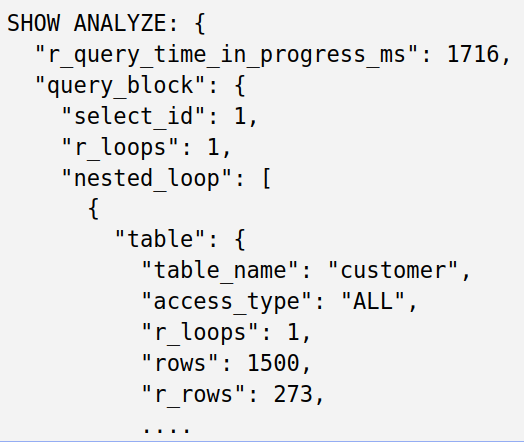Tag Archives: preview
At some point, nearly every developer encounters a common challenge: working with deeply nested JSON only to run into an arbitrary depth limit imposed by the database. In our case, that hard cap was set at 32 levels — sufficient for many scenarios but too restrictive for more complex or dynamic data structures. To address this, we decided to remove the limitation entirely.
The database now supports JSON documents and JSON paths with virtually unlimited nesting! This change unlocks the ability to work with more flexible and expressive data models without forcing developers to restructure or flatten their data.
…
Continue reading “Make JSON DEPTH unlimited – new feature in MariaDB 12.1”
One of the standout features of Oracle PL/SQL is the associative array — a versatile and efficient in-memory data structure that developers rely on for fast temporary lookups, streamlined batch processing, and dynamic report generation.
With the MariaDB 12.1 preview release, we’re excited to announce that associative arrays have landed in MariaDB as part of our growing set of Oracle compatibility features. This milestone, tracked under MDEV-34319, brings Oracle-style associative arrays into the MariaDB procedural language — complete with native type declarations, variable construction, and method support.
Let’s explore what’s included, what’s different, and how this feature was implemented from the ground up.
…
Continue reading “Bringing Oracle’s Associative Arrays to MariaDB”
We are pleased to announce the availability of a preview of the MariaDB 12.1 series. MariaDB 12.1 will be a rolling release.
MariaDB 12.1 introduces numerous new features, in particular
Performance improvements
- Segmented key cache for Aria (MDEV-24)
- MDL scalability improvements (MDEV-19749)
- Parallel replication for galera replicas (MDEV-20065)
- Buffered logging for audit plugin (MDEV-34680)
- Faster vector distance calculations via extrapolation (MDEV-36205)
Compatibility features
- caching_sha2_password plugin (MDEV-9804)
- ( + ) for outer join syntax (MDEV-13817)
- rpl_semi_sync_master_wait_for_slave_count (MDEV-18983)
- Associative arrays: DECLARE TYPE ..
…
The MariaDB Foundation is pleased to announce the availability of MariaDB 11.4.0, a preview release in the MariaDB 11.4 series. MariaDB 11.4 is a short-term release and will be maintained for one year after its G.A (stable) release.
The release contains the following new features. Note that as a preview release, not all features are guaranteed to make it into the MariaDB 11.4 series.
Partitioning
- ALTER TABLE … EXCHANGE PARTITION and ALTER TABLE … CONVERT TABLE … TO now support the WITH VALIDATION and WITHOUT VALIDATION clauses. If neither is specified, the default behavior is WITH VALIDATION (MDEV-22164)
Sys Schema
- New view sys.privileges_by_table_by_level shows granted privileges broken down by table on which they allow access and level on which they were granted.
…
Continue reading “MariaDB 11.4.0 preview release now available”
The MariaDB Foundation is pleased to announce the availability of MariaDB 11.3.0, a preview release in the MariaDB 11.3 series. MariaDB 11.3 is a short-term release and will be maintained for one year after its G.A (stable) release.
See the release notes for details.
Release Notes What is MariaDB 11.3?
Thanks, and enjoy MariaDB! …
The MariaDB Foundation is pleased to announce the availability of MariaDB 11.2.0, a preview release in the MariaDB 11.2 series. MariaDB 11.2 is a short-term release and will be maintained for one year after its G.A (stable) release.
See the release notes and changelogs for details.
Release Notes What is MariaDB 11.2?
Thanks, and enjoy MariaDB! …
SHOW ANALYZE
If you ever had to do query performance troubleshooting with MariaDB, you should be
familiar with MariaDB’s ANALYZE for statements feature. It does what EXPLAIN ANALYZE does in some other database systems: ANALYZE query runs the query and produces EXPLAIN output, amended with the data from the query execution:
FROM orders, customer
WHERE
customer.c_custkey = orders.o_custkey AND
customer.c_acctbal < 0 AND
orders.o_totalprice > 200*1000
+—-+————-+———-+——+—————+————-+———+——————–+——–+——–+———-+————+————-+
| id | select_type | table | type | possible_keys | key | key_len | ref | rows | r_rows | filtered | r_filtered | Extra |
+—-+————-+———-+——+—————+————-+———+——————–+——–+——–+———-+————+————-+
| 1 | SIMPLE | customer | ALL | PRIMARY,…
…
Continue reading “10.9 preview feature: SHOW ANALYZE and EXPLAIN FOR CONNECTION support”
The MariaDB 10.9 preview releases introduce a MySQL compatibility syntax extension, range notation. The ‘last’ keyword was added in JSON path expression, as requested in MDEV-22224 and MDEV-27911. Additionally, negative indexes are now also supported. Range notation, implemented using the ‘to’ keyword, and the ‘last’ keyword, is basically an array element selector.
Syntax:
Range notation:
[M to N] selects a range of elements starting from index M to N.
Last keyword:
[last-N] / [last] selects the Nth from last element, and last element, respectively.
…
Continue reading “10.9 preview feature: JSON path expression and JSON_OVERLAPS()”
